The Cambridge History of China. Vol. 13: Republican China 1912-1949, Part 2
Подождите немного. Документ загружается.


HIGHER EDUCATION AND NATION-BUILDING 4°I
surveys originally inspired by a YMCA secretary, who in 1912 formed the
Peking Students Social Service Club
in
order
to
bring the members more
into contact with
the
facts
of
Chinese life.
By 1915
this group
had
conducted a pioneer study
of
3 20
Peking rickshaw-pullers, an eye-opening
look
at the
human condition later immortalized
by the
novelist Lao
She
(see
ch.
9).
The
'social survey wing'
of
the
Yenching Sociology
Department
set up
in
1928
a
rural research station
in
the
village
of
Ch'ing-ho, three miles north
of
the new Yenching campus north-west
of
Peking.
113
Building
on
this beginning
in
social survey work, Western-
trained Chinese sociologists
at
Yenching then proceeded
to
lay the
foundations
of
this science
in
China. This growth
at
Yenching was
led
by Wu Wen-tsao, who arrived
in
1929 from Columbia where
he
had met
J.
S.
Burgess
and
studied sociology.
Wu
Wen-tsao's leadership
and
planning, sending
his
students abroad, produced
a
group who played
a
dominant role
in
developing their field.
Its
growth was stimulated when
leading American
and
British sociologists visited
and
lectured
at
Yenching.'
I4
Social research, as always, required a basis of historical and institutional
knowledge.
By
1928
L. K. T'ao (T'ao
Meng-ho)
who had
finished
his
London B.A.
in
1912, was head of
the
Peiping Institute
of
Social Research
supported
by the
China Foundation.
Its
researchers among other things
began
to
explore the newly opened Ch'ing archives
for
purposes
of
social
and economic institutional history.
115
In
1934
it
merged with
the
Academia Sinica Institute
of
Social Research.
Field work was also pursued
by the
Institute
for
Research
in
Chinese
Architecture.
It
had
been founded
by a
prominent ex-official
(Chu
Chi-ch'ien)
in
1928
but
pursued mainly library research until after 1930,
when
its
field explorations
to
discover ancient monuments
-
temples,
pagodas, bridges
-
were
led by two
architects trained
at the
University
of Pennsylvania, Liang Ssu-ch'eng
and his
wife
Lin
Hui-yin,
and
a
Japan-trained colleague,
Liu
Tun-chen. Here again,
a
new
scientific
interest, aided
by
imported methods,
led to
historic discoveries.
116
113
In this development J. S. Burgess, who had represented Princeton-in-Peking, worked with Hsu
Shih-lien (Leonard Hsu). Burgess and Sidney Gamble published
in
1921
Peking:
a
social
survey.
See Yung-chen Chiang, 'The Yenching Sociology Department: from social service
to
social
engineering 1919-1945' (unpublished paper, 1984, cited with author's permission).
See
also
David Arkush,
Fei
Xiaotong
{Fei
Hsiao-fung) and
sociology
in
revolutionary
China.
114
His
students included
Fei
Hsiao-t'ung {peasant life
in
China),
Iin
Yueh-hua {The golden wing:
a
sociological study
of Chinese familism) and C.
K.
Yang (Yang Ch'ing-k'un) (Religion in
Chinese
society);
see also Francis
L. K.
Hsu, Under the
ancestor's
shadow:
Chinese
culture and personality.
1
' * See the files
of
Cbung-kuo
cbin-tai
cbing-cbi shihyen-chiu
cbi-k'an (Studies
in
modern economic history
of China).
116
See introduction
by
Wilma Fairbank
to
Liang Ssu-ch'eng,
A
pictorial
history
of
Chinese
architecture:
a study
of
the development
of its
structural system and the
evolution
of its
types.
Cambridge Histories Online © Cambridge University Press, 2008
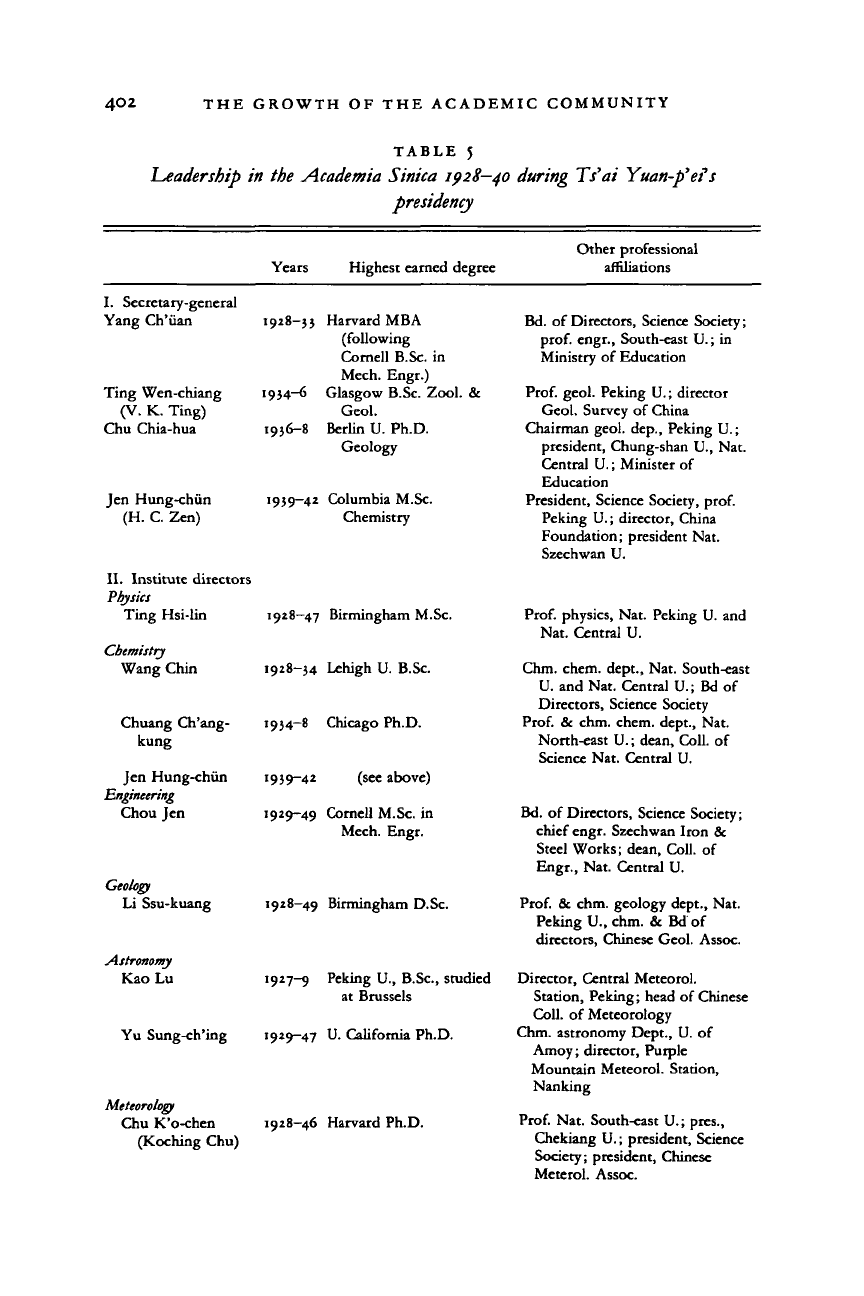
4O2
THE GROWTH OF THE ACADEMIC COMMUNITY
TABLE 5
Leadership
in
the
Academic Sinica 1928-40 during Ts'ai Yuan-p'efs
presidency
Years Highest earned degree
Other professional
affiliations
I. Secretary-general
Yang Ch'iian
Ting Wen-chiang
(V.
K.
Ting)
Chu Chia-hua
Jen Hung-chiin
(H.
C.
Zen)
1928-33 Harvard
MBA
(following
Cornell
B.Sc.
in
Mech. Engr.)
1934-6 Glasgow B.Sc. Zool.
&
Geol.
1936-8 Berlin
U. Ph.D.
Geology
1939—42 Columbia
M.Sc.
Chemistry
II.
Institute directors
Physics
Ting Hsi-Un 1928-47 Birmingham
M.Sc.
Chemistry
Wang Chin
Chuang Ch'ang-
kung
Jen Hung-chiin
Engineering
Chou
Jen
1928-34 Lehigh
U. B.Sc.
1934-8 Chicago
Ph.D.
1939-42
(see
above)
1929-49 Cornell M.Sc.
in
Mech. Engr.
Li Ssu-kuang 1928-49 Birmingham
D.Sc.
Astronomy
KaoLu
1927-9 Peking
U.,
B.Sc., studied
at Brussels
Yu Sung-ch'ing 1929—47
U.
California
Ph.D.
Meteorology
Chu K'o-chen 1928-46 Harvard
Ph.D.
(Koching
Chu)
Bd.
of
Directors, Science Society;
prof,
engr., South-east
U.;
in
Ministry
of
Education
Prof.
geol. Peking
U.;
director
Geol. Survey
of
China
Chairman geol.
dep.,
Peking
U.;
president, Chung-shan
U., Nat.
Central
U.;
Minister
of
Education
President, Science Society,
prof.
Peking
U.;
director, China
Foundation; president
Nat.
Szechwan
U.
Prof,
physics,
Nat.
Peking
U. and
Nat. Central
U.
Chm. chem. dept.,
Nat.
South-east
U.
and Nat.
Central
U.; Bd of
Directors, Science Society
Prof.
&
chm.
chem. dept.,
Nat.
North-east
U.;
dean, Coll.
of
Science
Nat.
Central
U.
Bd.
of
Directors, Science Society;
chief engr. Szechwan Iron
&
Steel Works; dean, Coll.
of
Engr.,
Nat.
Central
U.
Prof.
&
chm.
geology dept.,
Nat.
Peking
U., chm.
&
Bd of
directors, Chinese Geol. Assoc.
Director, Central Meteorol.
Station, Peking; head
of
Chinese
Coll.
of
Meteorology
Chm. astronomy Dept.,
U.
of
Amoy; director, Purple
Mountain Meteorol. Station,
Nanking
Prof.
Nat.
South-east
U.;
pres.,
Chekiang
U.;
president, Science
Society; president, Chinese
Meterol. Assoc.
Cambridge Histories Online © Cambridge University Press, 2008
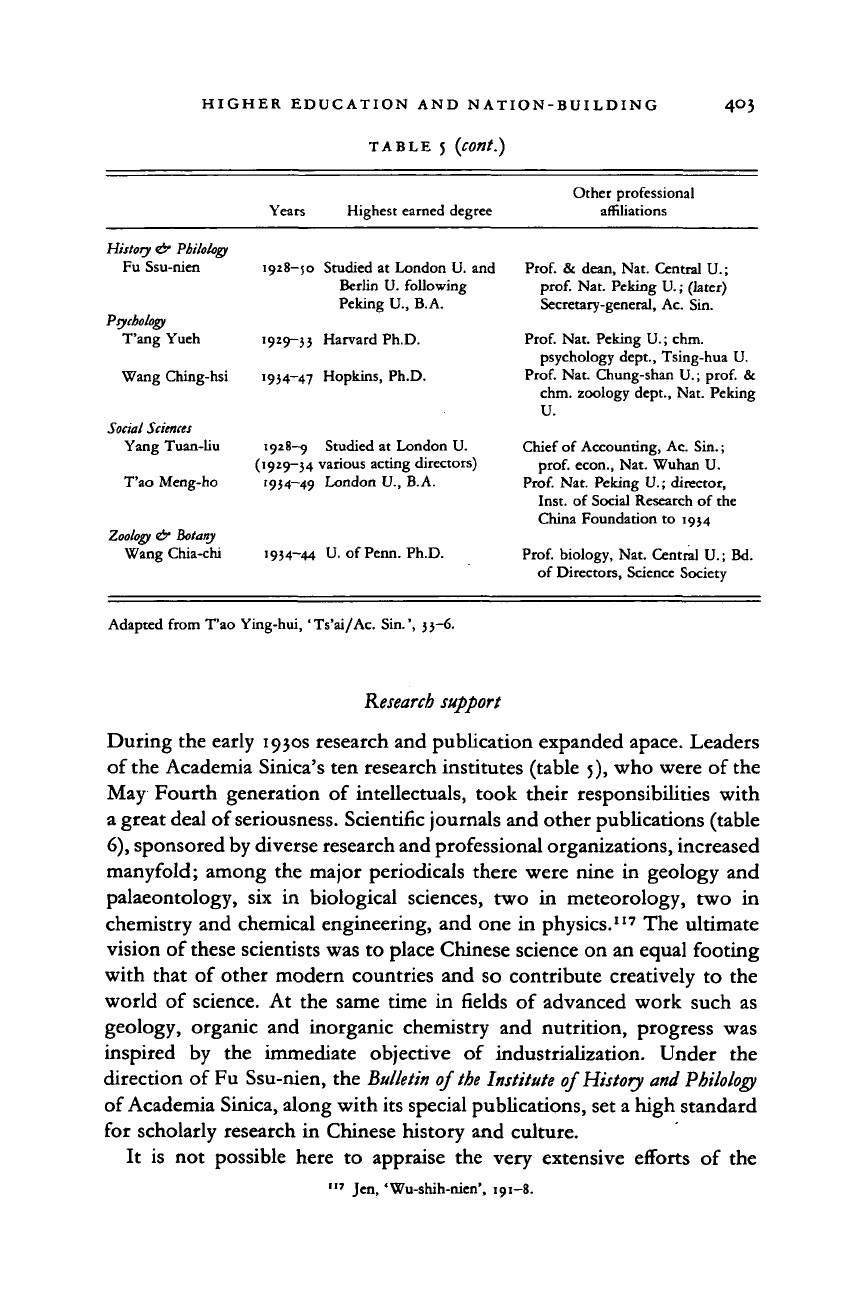
HIGHER EDUCATION AND NATION-BUILDING
TABLE
5
(cont.)
403
History
&
Philology
Fu Ssu-nien
Psychology
T'ang Yueh
Wang Ching-hsi
Social
Sciences
Yang Tuan-liu
T'ao Meng-ho
Zoology
&
Botany
Wang Chia-chi
Years Highest earned degree
1928-50 Studied
at
London
U. and
Berlin
U.
following
Peking
U., B.A.
1929-33 Harvard
Ph.D.
1934—47 Hopkins,
Ph.D.
1928-9 Studied
at
London
U.
(1929—34 various acting directors)
1934-49 London
U., B.A.
1934-44
U. of
Perm.
Ph.D.
Other professional
affiliations
Prof.
&
dean,
Nat.
Central
U.;
prof.
Nat.
Peking
U.;
(later)
Secretary-general,
Ac. Sin.
Prof.
Nat.
Peking
U.; chm.
psychology dept., Tsing-hua
U.
Prof.
Nat.
Chung-shan
U.;
prof.
&
chm. zoology dept.,
Nat.
Peking
TT
Chief
of
Accounting,
Ac. Sin.;
prof,
econ.,
Nat.
Wuhan
U.
Prof.
Nat.
Peking
U.;
director,
Inst.
of
Social Research
of the
China Foundation
to 1934
Prof,
biology,
Nat.
Central
U.; Bd.
of Directors, Science Society
Adapted from
T'ao
Ying-hui, 'Ts'ai/Ac. Sin.',
33-6.
Research support
During
the
early 1930s research
and
publication expanded apace. Leaders
of the Academia Sinica's
ten
research institutes (table 5),
who
were
of the
May Fourth generation
of
intellectuals, took their responsibilities with
a great deal
of
seriousness.
Scientific journals
and
other publications (table
6),
sponsored by diverse research and professional organizations, increased
manyfold; among
the
major periodicals there were nine
in
geology
and
palaeontology,
six
in
biological sciences,
two
in
meteorology,
two
in
chemistry
and
chemical engineering,
and one in
physics.
117
The
ultimate
vision
of
these scientists
was to
place Chinese science
on an
equal footing
with that
of
other modern countries
and so
contribute creatively
to
the
world
of
science.
At the
same time
in
fields
of
advanced work such
as
geology, organic
and
inorganic chemistry
and
nutrition, progress
was
inspired
by the
immediate objective
of
industrialization. Under
the
direction
of Fu
Ssu-nien,
the
Bulletin
of
the
Institute
of
History
and
Philology
of Academia Sinica, along with
its
special publications,
set a
high standard
for scholarly research
in
Chinese history
and
culture.
It
is
not
possible here
to
appraise
the
very extensive efforts
of
the
117
Jen,
'Wu-shih-nien', 191-8.
Cambridge Histories Online © Cambridge University Press, 2008
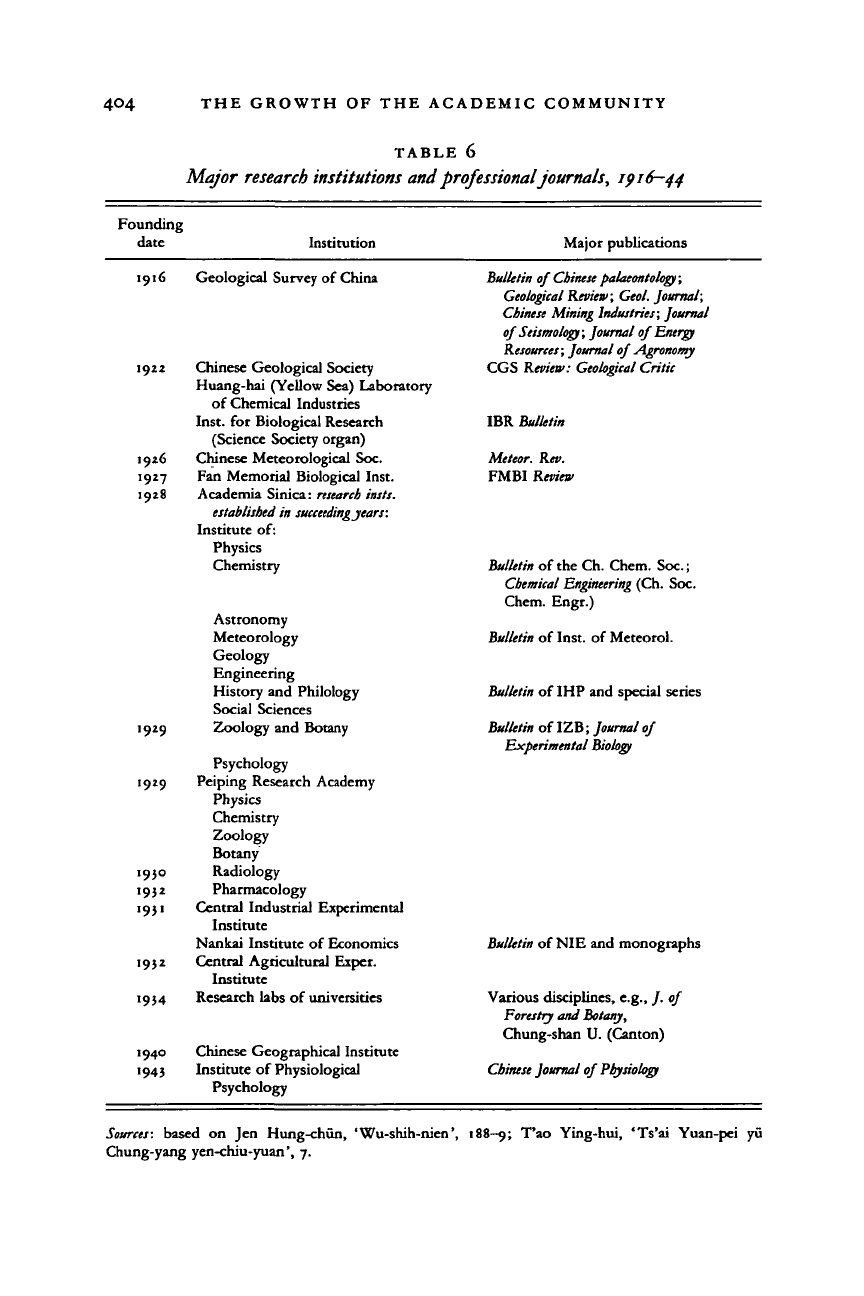
404
THE GROWTH OF THE ACADEMIC COMMUNITY
TABLE 6
Major
research
institutions and professional journals,
1916—44
Founding
date Institution
1916 Geological Survey of China
1922 Chinese Geological Society
Major publications
Bulletin of Chine st palaemtolog);
Geological Review,
Geol.
journal;
Chinese Mining Industries; journal
of
Seismology;
journal of
Energy
Resources;
Journal of Agronomy
CGS Review: Geological Critic
Huang-hai (Yellow Sea) Laboratory
of Chemical Industries
Inst. for Biological Research
(Science Society organ)
1926 Chinese Meteorological Soc.
1927 Fan Memorial Biological Inst.
1928 Academia Sinica:
rtsearcb
insts.
established in succadingjears:
Institute of:
Physics
IBR Bulletin
Meteor. Rev.
FMBI Review
1929
1929
1930
1932
1931
1932
•934
1940
'943
Chemistry
Astronomy
Meteorology
Geology
Engineering
History and Philology
Social Sciences
Zoology and Botany
Psychology
Peiping Research Academy
Physics
Chemistry
Zoology
Botany
Radiology
Pharmacology
Central Industrial Experimental
Institute
Nankai Institute of Economics
Central Agricultural Exper.
Institute
Research labs of universities
Chinese Geographical Institute
Institute of Physiological
Psychology
Bulletin
of the Ch. Chem. Soc.;
Chemical
Engineering
(Ch. Soc.
Chem. Engr.)
Bulletin
of Inst. of Meteorol.
Bulletin
of IHP and special series
Bulletin of IZB; journal of
Experimental
Biology
Bulletin
of NIE and monographs
Various disciplines, e.g., /. of
Forestry and Botany,
Chung-shan U. (Canton)
Chinese
Journal of
Physiology
Sources:
based on Jen Hung-chun, 'Wu-shih-nien', 188-9; T'ao Ying-hui, 'Ts'ai Yuan-pei yu
Chung-yang yen-chiu-yuan', 7.
Cambridge Histories Online © Cambridge University Press, 2008

HIGHER EDUCATION AND NATION-BUILDING 405
Ministry
of
Education
in
Nanking, where Wang Shih-chieh, former
president of Wuhan University, served as Minister of Education from 1933
to 1937. The ministry was charged with promotion of the national school
system, campaigns
for
literacy, and the setting
of
standards
for
middle-
school graduation
and
admission
to
college. Quite separate from
the
ministry and under the protection
of
the unequal treaty system, which
assured
a
steady flow
of
funds from the central government, the China
Foundation bore a special responsibility for aiding advanced training and
research. While developing separately,
the
expanding activities
of the
China Foundation interpenetrated those
of the
universities
and the
Academia Sinica, for the funding programmes of the foundation touched
a wide range
of
scholarship.
A
summary
of
the grants awarded
by the
China Foundation in the two decades 1926-45 shows that 96 institutions
-
including universities and colleges, research institutions, and cultural and
educational organizations
-
were assisted
by
grants that reached
a
total
of Ch. $24,250,893 plus US $392,795.
II8
The projects launched or financially assisted by the foundation fell into
several categories."
9
(1) A direct cooperation from 1931
to
1937 with the
National Peking University, whereby each contributed
Ch.
$200,000
annually
to
subsidize faculty salaries
and to
support released time
for
research. The
aid
from
the
China Foundation drastically reduced
the
number
of
professors holding concurrent teaching positions
in
other
institutions; and now that professors could have more time for their own
scholarly pursuits with improved salaries, the morale at Peita was greatly
improved, to the point where several distinguished scholars were attracted
to
the
faculty.
(2) The
establishment
of
science professorships
in six
leading normal colleges chosen with geographical diversity
in
view:
Mukden, Nanking, Wuchang, Canton,
and
Chengtu.
(3)
Grants
of
research fellowships
to
senior scientists
for the
furtherance
of
their
research; these (table
7)
were long-term grants awarded
to a
limited
number of individuals whose professional work already had gained wide
recognition.
(4)
Scientific research fellowships
for
younger scholars
in
the natural and social sciences
for
advanced training either
in
China
or
abroad.
Of
the 732 fellowships and
3
special prizes given
out
between
1928 and 1945 (table 8), 327 fellows did their advanced study and research
in China; among those who went abroad, 208 went to the United States,
64
to
France, 56
to
Germany,
and 39 to
Britain. Their specializations
ranged broadly from agriculture
and
archaeology, through botany,
chemistry, and dozens of other fields to zoology.
It
was notable that soil
118
Summary report,
5.
"• The present account is based on
ibid.
6-16, and Peter Buck, 221-4.
Cambridge Histories Online © Cambridge University Press, 2008
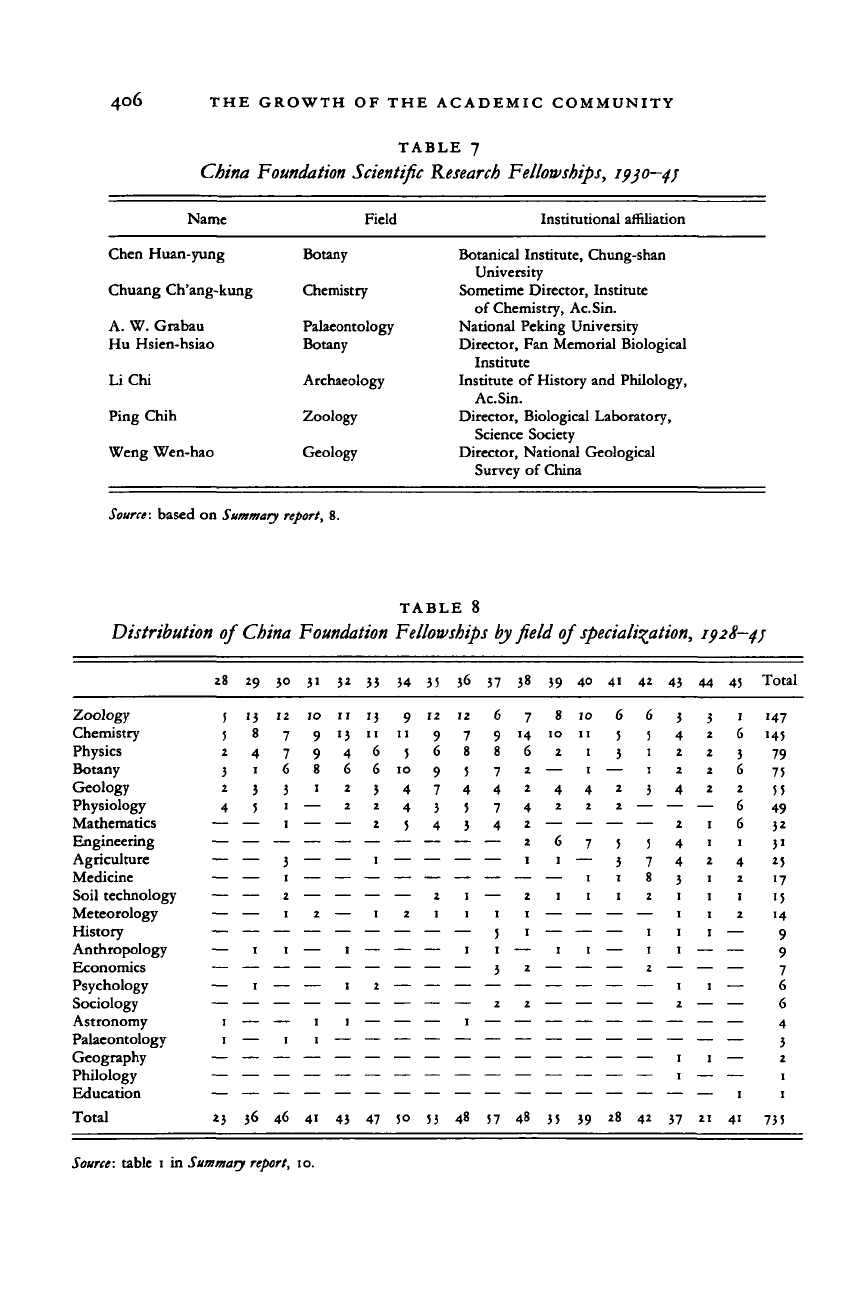
406 THE GROWTH OF THE ACADEMIC COMMUNITY
TABLE 7
China Foundation Scientific
Kesearch
Fellowships, ipjo-4j
Name Field Institutional affiliation
Chen Huan-yung Botany Botanical Institute, Chung-shan
University
Chuang Ch'ang-kung Chemistry Sometime Director, Institute
of Chemistry, Ac.Sin.
A. W. Grabau Palaeontology National Peking University
Hu Hsien-hsiao Botany Director, Fan Memorial Biological
Institute
Li Chi Archaeology Institute of History and Philology,
Ac.
Sin.
Ping Chih Zoology Director, Biological Laboratory,
Science Society
Weng Wen-hao Geology Director, National Geological
Survey of China
Source: based
on
Summary
report,
8.
TABLE 8
Distribution
of
China Foundation Fellowships by field of
specialisation,
1928—4;
28
29 jo 31 32 33 34 35 36 37 38 39 40 41 42 43 44 4j
Total
Zoology
; 13 12 10 11 13 9 12 12 6 7 8 10 6 6 3 3 1 147
Chemistry
5 8 7
9131111
9 7 9 14 10 11 5 5 4 2 6 145
Physics 247946568862131223
79
Botany
3
16866
10
9572
— 1 — 1226 75
Geology 233123474424423422
55
Physiology
4 5 ' —
2243574222
— — — 6 49
Mathematics
— — 1 — — 2 5 4 3 4 2 — — — — 2 1 6 32
Engineering
— — — — — — — — — — 2 6 7 5 5 4 1 1 31
Agriculture
— — 3 — — 1 — — — — 1 1 — 3 7 4 2 4 25
Medicine
— — 1 — — — — — — — — — 1 1 8 3 1 2 17
Soil technology
— — 2 — — — — 2 1 — 2 1 1 1 2 1 1 1 15
Meteorology
— — 12 —
121111
— — — — 112 14
History
— — — — — — — — — 5 1 — — — 1 1 1 — 9
Anthropology
— 1 1 — 1— — — 1 1— 1 1 — 1 1 — — 9
Economics
— — — — — — — — — 3 2 — — — 2 — — — 7
Psychology
— 1 — — i 2 — — — — — — — — — 1 1 •— 6
Sociology
— — — — — — — — — 2 2 — — — — 2 — — 6
Astronomy
1 — — 1 1 — — — 1 — — — — — — — — — 4
Palaeontology
1 — 1 1 — — •— — — — — — — — — — — — 3
Geography
— — — — — — — — — — — — — — — 1 1 — 2
Philology
— — — — — — — — — — — — — — — 1 — — 1
Education
— — — — — — — — — — — — — — — — — 1 1
Total
23 36 46 41 43 47 50 53 48 57 48 35 39 28 42 37 21 41 735
Source: table
1 in
Summary
report,
10.
Cambridge Histories Online © Cambridge University Press, 2008
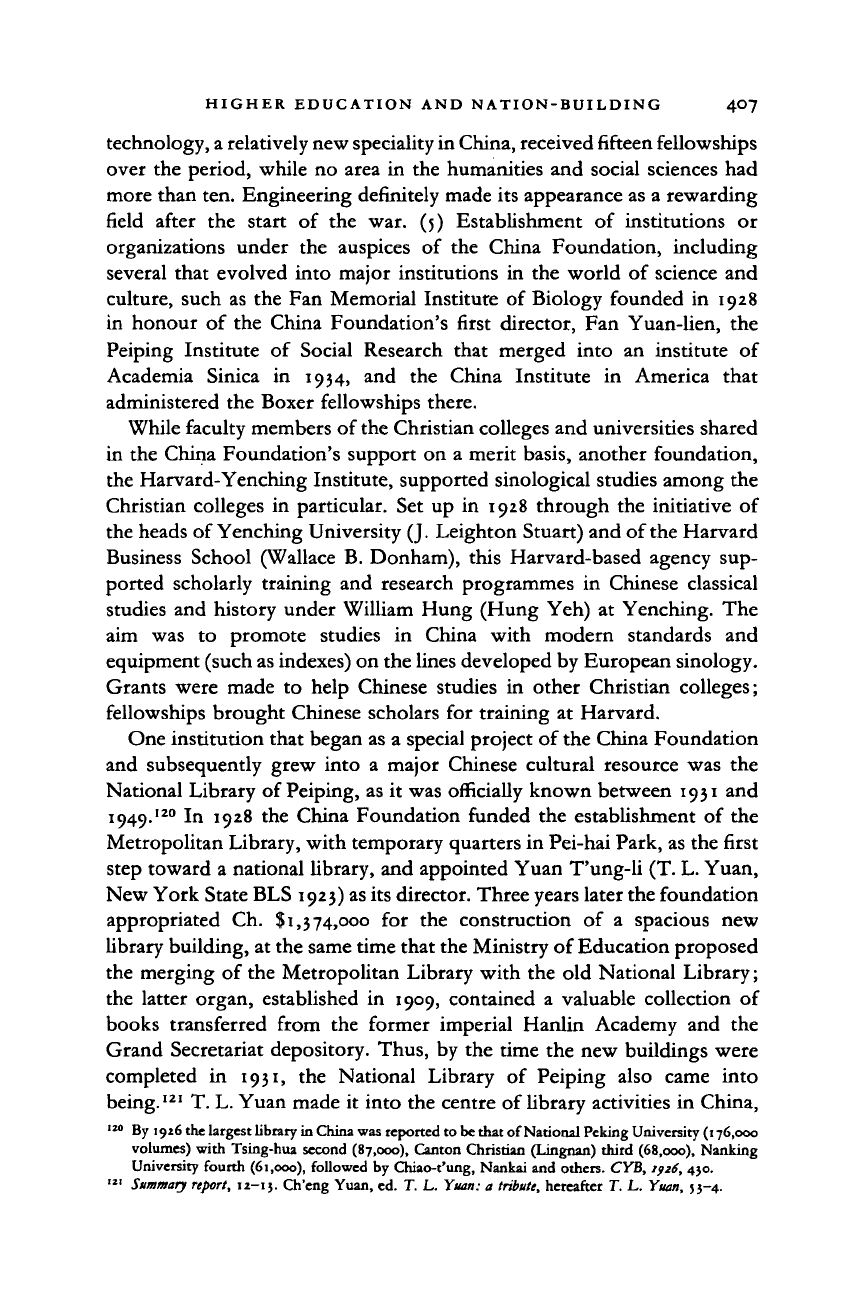
HIGHER EDUCATION AND NATION-BUILDING 407
technology, a relatively new speciality in China, received fifteen fellowships
over the period, while no area in the humanities and social sciences had
more than ten. Engineering definitely made its appearance as a rewarding
field after
the
start
of the
war.
(5)
Establishment
of
institutions
or
organizations under
the
auspices
of
the China Foundation, including
several that evolved into major institutions
in
the world
of
science and
culture, such as the Fan Memorial Institute
of
Biology founded
in
1928
in honour
of
the China Foundation's first director, Fan Yuan-lien,
the
Peiping Institute
of
Social Research that merged into
an
institute
of
Academia Sinica
in
1934,
and the
China Institute
in
America that
administered the Boxer fellowships there.
While faculty members of the Christian colleges and universities shared
in the China Foundation's support on
a
merit basis, another foundation,
the Harvard-Yenching Institute, supported sinological studies among the
Christian colleges
in
particular. Set up
in
1928 through the initiative
of
the heads of Yenching University (J. Leighton Stuart) and of the Harvard
Business School (Wallace B. Donham), this Harvard-based agency sup-
ported scholarly training and research programmes
in
Chinese classical
studies and history under William Hung (Hung Yeh)
at
Yenching. The
aim
was to
promote studies
in
China with modern standards
and
equipment (such as indexes) on the lines developed by European sinology.
Grants were made
to
help Chinese studies
in
other Christian colleges;
fellowships brought Chinese scholars for training
at
Harvard.
One institution that began as a special project of the China Foundation
and subsequently grew into
a
major Chinese cultural resource was
the
National Library of Peiping, as
it
was officially known between 1931 and
i949.
IZ0
In
1928 the China Foundation funded the establishment
of
the
Metropolitan Library, with temporary quarters in Pei-hai Park, as the first
step toward a national library, and appointed Yuan T'ung-li (T. L. Yuan,
New York State BLS 1923) as its director. Three years later the foundation
appropriated
Ch.
$1,374,000
for the
construction
of a
spacious
new
library building, at the same time that the Ministry of Education proposed
the merging
of
the Metropolitan Library with the old National Library;
the latter organ, established
in
1909, contained
a
valuable collection
of
books transferred from
the
former imperial Hanlin Academy
and the
Grand Secretariat depository. Thus, by the time the new buildings were
completed
in
1931,
the
National Library
of
Peiping also came into
being.
121
T. L. Yuan made
it
into the centre of library activities in China,
120
By 1926 the largest library in China was reported to be that ofNational Peking University (176,000
volumes) with Tsing-hua second (87,000), Canton Christian (Lingnan) third (68,000), Nanking
University fourth (61,000), followed by Chiao-t'ung, Nankai and others.
CYB,
1926, 430.
121
Summary report, 12-15. Ch'eng Yuan, ed.
T.
L. Yuan:
a
tribute, hereafter
T. L.
Yuan, 53-4.
Cambridge Histories Online © Cambridge University Press, 2008
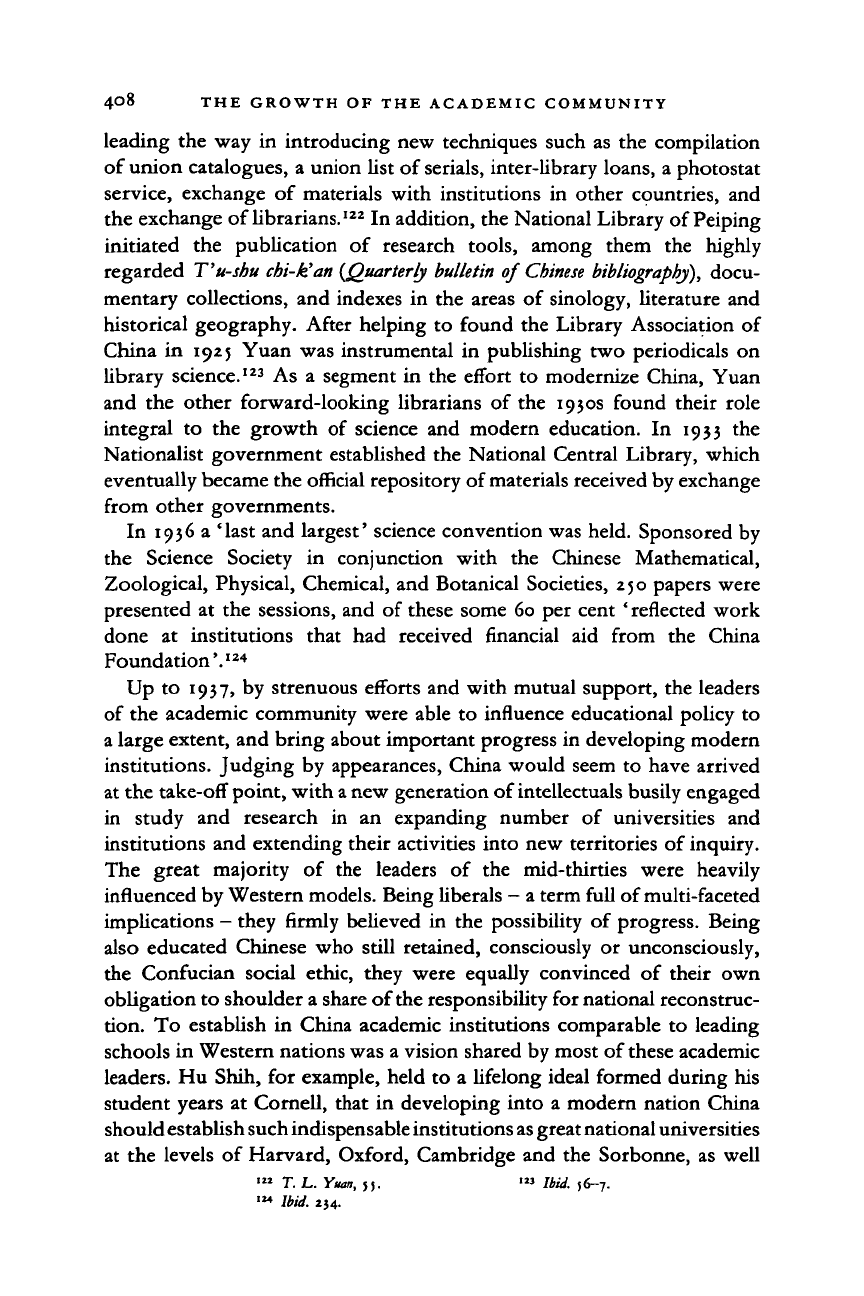
4°8 THE GROWTH OF THE ACADEMIC COMMUNITY
leading the way
in
introducing new techniques such
as the
compilation
of union catalogues,
a
union list
of
serials,
inter-library loans, a photostat
service, exchange
of
materials with institutions
in
other countries,
and
the exchange of librarians.
122
In addition, the National Library of Peiping
initiated
the
publication
of
research tools, among them
the
highly
regarded
T'u-shu
chi-k'an {Quarterly bulletin
of
Chinese
bibliography), docu-
mentary collections, and indexes
in
the areas
of
sinology, literature and
historical geography. After helping
to
found the Library Association
of
China
in
1925 Yuan was instrumental
in
publishing two periodicals
on
library science.
123
As a
segment
in
the effort
to
modernize China, Yuan
and
the
other forward-looking librarians
of
the 1930s found their role
integral
to the
growth
of
science
and
modern education.
In
1933
the
Nationalist government established the National Central Library, which
eventually became the official repository of materials received by exchange
from other governments.
In 1936
a
'last and largest' science convention was held. Sponsored by
the Science Society
in
conjunction with
the
Chinese Mathematical,
Zoological, Physical, Chemical, and Botanical Societies, 250 papers were
presented
at
the sessions, and
of
these some 60 per cent ' reflected work
done
at
institutions that
had
received financial
aid
from
the
China
Foundation'.
124
Up
to
1937, by strenuous efforts and with mutual support, the leaders
of the academic community were able
to
influence educational policy
to
a large extent, and bring about important progress in developing modern
institutions. Judging by appearances, China would seem
to
have arrived
at the take-off point, with
a
new generation of intellectuals busily engaged
in study
and
research
in an
expanding number
of
universities
and
institutions and extending their activities into new territories
of
inquiry.
The great majority
of the
leaders
of the
mid-thirties were heavily
influenced by Western models. Being liberals
-
a term full of multi-faceted
implications
-
they firmly believed
in the
possibility
of
progress. Being
also educated Chinese who still retained, consciously
or
unconsciously,
the Confucian social ethic, they were equally convinced
of
their
own
obligation to shoulder a share of the responsibility for national reconstruc-
tion.
To
establish
in
China academic institutions comparable
to
leading
schools in Western nations was a vision shared by most of these academic
leaders.
Hu
Shih,
for
example, held
to a
lifelong ideal formed during his
student years
at
Cornell, that
in
developing into
a
modern nation China
should establish such indispensable institutions
as
great national universities
at the levels
of
Harvard, Oxford, Cambridge and the Sorbonne,
as
well
'" T.
L.
Yuan,
5J
. '«
Ibid. 56-7.
IM
Ibid. 234.
Cambridge Histories Online © Cambridge University Press, 2008
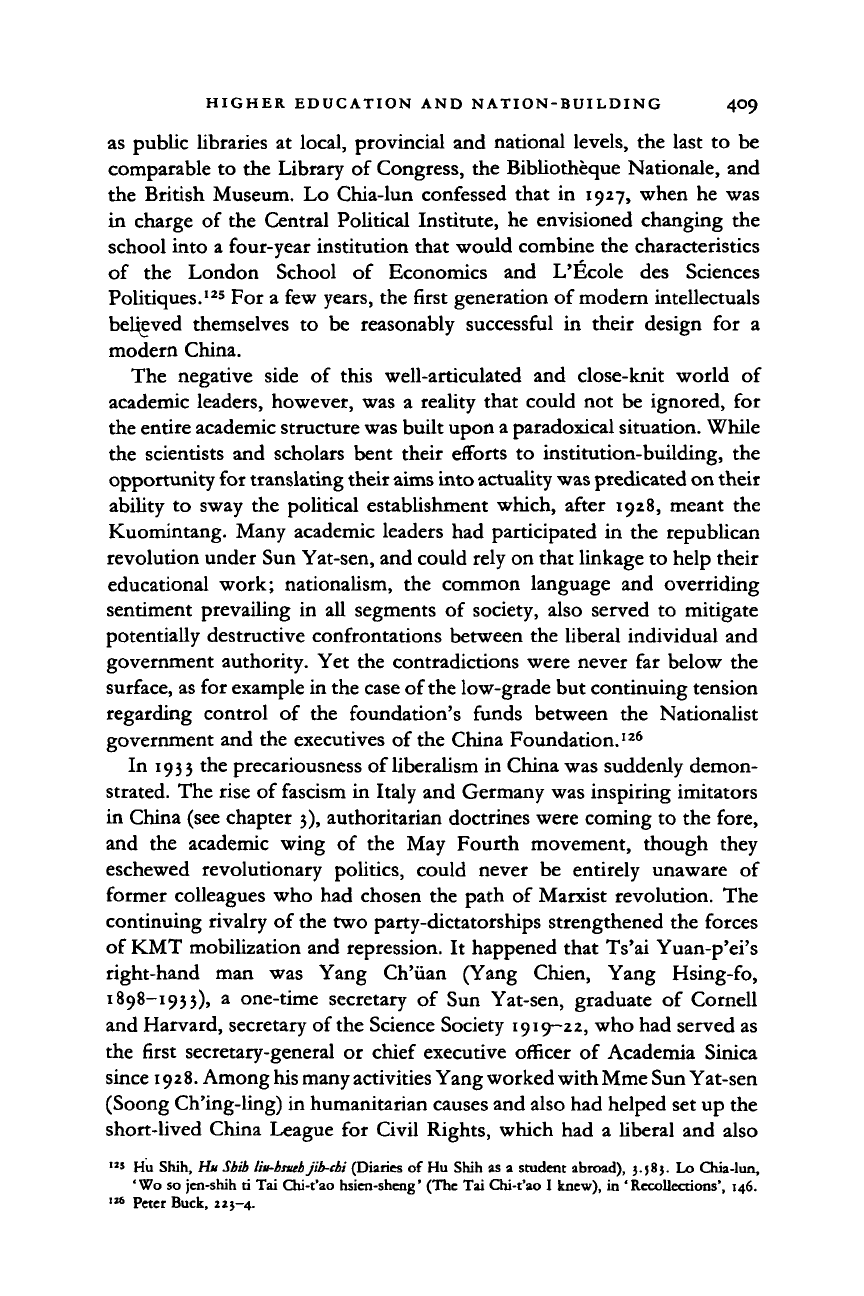
HIGHER EDUCATION AND NATION-BUILDING 409
as public libraries
at
local, provincial and national levels, the last
to be
comparable to the Library
of
Congress, the Bibliotheque Nationale, and
the British Museum. Lo Chia-lun confessed that
in
1927, when
he
was
in charge
of
the Central Political Institute,
he
envisioned changing
the
school into a four-year institution that would combine the characteristics
of
the
London School
of
Economics
and
L'Ecole
des
Sciences
Politiques.
125
For a few years, the first generation of modern intellectuals
believed themselves
to be
reasonably successful
in
their design
for a
modern China.
The negative side
of
this well-articulated
and
close-knit world
of
academic leaders, however, was
a
reality that could not
be
ignored,
for
the entire academic structure was built upon a paradoxical situation. While
the scientists and scholars bent their efforts
to
institution-building,
the
opportunity for translating their
aims
into actuality was predicated on their
ability
to
sway the political establishment which, after 1928, meant
the
Kuomintang. Many academic leaders had participated
in
the republican
revolution under Sun Yat-sen, and could rely on that linkage to help their
educational work; nationalism,
the
common language
and
overriding
sentiment prevailing
in all
segments
of
society, also served
to
mitigate
potentially destructive confrontations between the liberal individual and
government authority. Yet the contradictions were never
far
below the
surface, as for example in the case of the low-grade but continuing tension
regarding control
of the
foundation's funds between
the
Nationalist
government and the executives of the China Foundation.
126
In 1933 the precariousness of liberalism in China was suddenly demon-
strated. The rise of fascism in Italy and Germany was inspiring imitators
in China (see chapter 3), authoritarian doctrines were coming to the fore,
and
the
academic wing
of the
May Fourth movement, though they
eschewed revolutionary politics, could never
be
entirely unaware
of
former colleagues who had chosen the path
of
Marxist revolution. The
continuing rivalry of the two party-dictatorships strengthened the forces
of KMT mobilization and repression.
It
happened that Ts'ai Yuan-p'ei's
right-hand
man was
Yang Ch'iian (Yang Chien, Yang Hsing-fo,
1898-193
3),
a
one-time secretary
of
Sun Yat-sen, graduate
of
Cornell
and Harvard, secretary of the Science Society 1919—22, who had served as
the first secretary-general
or
chief executive officer
of
Academia Sinica
since
1928.
Among
his
many activities Yang worked with
Mme
Sun Yat-sen
(Soong Ch'ing-ling) in humanitarian causes and also had helped set up the
short-lived China League
for
Civil Rights, which had
a
liberal and also
125
Hu Shih, H*
Sbib
liu-bsiub jib-tbi (Diaries
of
Hu Shih as a student abroad), 3.583. Lo Chia-lun,
'Wo so jen-shih ti Tai Chi-t'ao hsien-sheng' (The Tai Chi-t'ao
I
knew), in 'Recollections', 146.
'" Peter Buck, 2Z3-4.
Cambridge Histories Online © Cambridge University Press, 2008
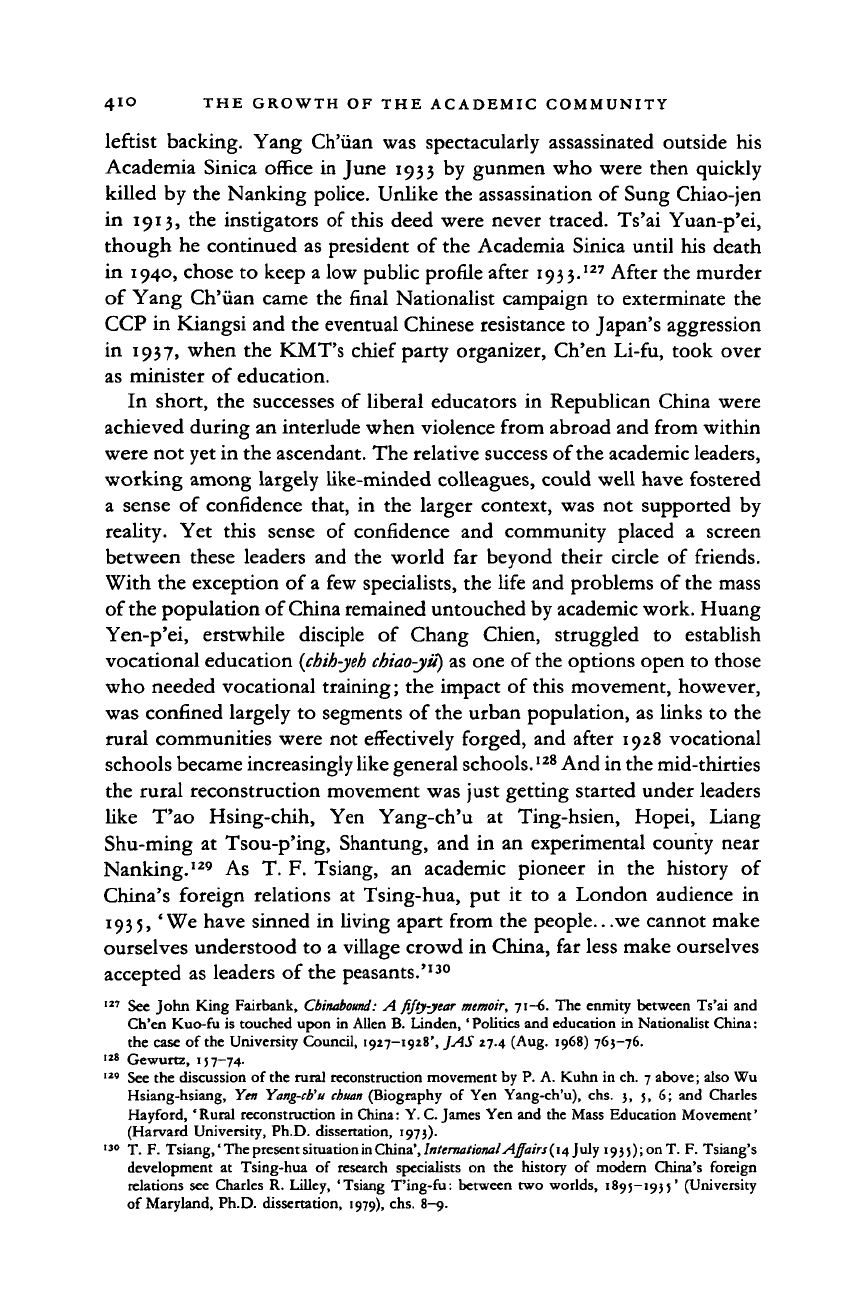
4IO THE GROWTH OF THE ACADEMIC COMMUNITY
leftist backing. Yang Ch'iian was spectacularly assassinated outside
his
Academia Sinica office in June 1933 by gunmen who were then quickly
killed by the Nanking police. Unlike the assassination
of
Sung Chiao-jen
in 1913, the instigators of this deed were never traced. Ts'ai Yuan-p'ei,
though he continued as president of the Academia Sinica until his death
in 1940, chose to keep a low public profile after
1933.
127
After the murder
of Yang Ch'iian came the final Nationalist campaign
to
exterminate the
CCP in Kiangsi and the eventual Chinese resistance to Japan's aggression
in 1937, when the KMT's chief party organizer, Ch'en Li-fu, took over
as minister of education.
In short, the successes
of
liberal educators
in
Republican China were
achieved during an interlude when violence from abroad and from within
were not yet in the ascendant. The relative success of the academic leaders,
working among largely like-minded colleagues, could well have fostered
a sense
of
confidence that,
in
the larger context, was not supported
by
reality.
Yet
this sense
of
confidence
and
community placed
a
screen
between these leaders and the world
far
beyond their circle
of
friends.
With the exception of a few specialists, the life and problems of the mass
of the population of China remained untouched by academic work. Huang
Yen-p'ei, erstwhile disciple
of
Chang Chien, struggled
to
establish
vocational education
(chih-jeh chiao-ju)
as one of the options open to those
who needed vocational training; the impact of this movement, however,
was confined largely to segments of the urban population, as links to the
rural communities were not effectively forged, and after 1928 vocational
schools became increasingly like general schools.
I28
And in the mid-thirties
the rural reconstruction movement was just getting started under leaders
like
T'ao
Hsing-chih,
Yen
Yang-ch'u
at
Ting-hsien, Hopei, Liang
Shu-ming
at
Tsou-p'ing, Shantung, and
in
an experimental county near
Nanking.
129
As
T. F. Tsiang,
an
academic pioneer
in the
history
of
China's foreign relations
at
Tsing-hua, put
it to a
London audience
in
1935,
' We have sinned in living apart from the people.. .we cannot make
ourselves understood to a village crowd in China, far less make ourselves
accepted as leaders of the peasants.'
130
127
See
John King Fairbank, Cbitubound:
A
fifty-jear memoir, 71-6.
The
enmity between Ts'ai
and
Ch'en Kuo-fu
is
touched upon
in
Allen B. Linden,
'
Politics and education
in
Nationalist China:
the case
of
the University Council, 1927-1928',
JAS
27.4 (Aug. 1968) 765-76.
128
Gewurtz, 157-74.
125
See the discussion of the rural reconstruction movement by P. A. Kuhn in ch. 7 above; also Wu
Hsiang-hsiang, Yen
Yang-cb'u chuan
(Biography
of
Yen Yang-ch'u), chs.
3, 5, 6;
and Charles
Hayford, 'Rural reconstruction in China: Y. C. James Yen and the Mass Education Movement'
(Harvard University, Ph.D. dissertation, 197}).
130 T. F. Tsiang,"rnepresentsituationinChina',/B/enM/»«a/y4^a»'«(i4july i93j);onT. F. Tsiang's
development
at
Tsing-hua
of
research specialists
on the
history
of
modern China's foreign
relations see Charles R. Iilley, 'Tsiang T'ing-fu: between two worlds,
1895—193} *
(University
of Maryland, Ph.D. dissertation, 1979), chs. 8-9.
Cambridge Histories Online © Cambridge University Press, 2008
